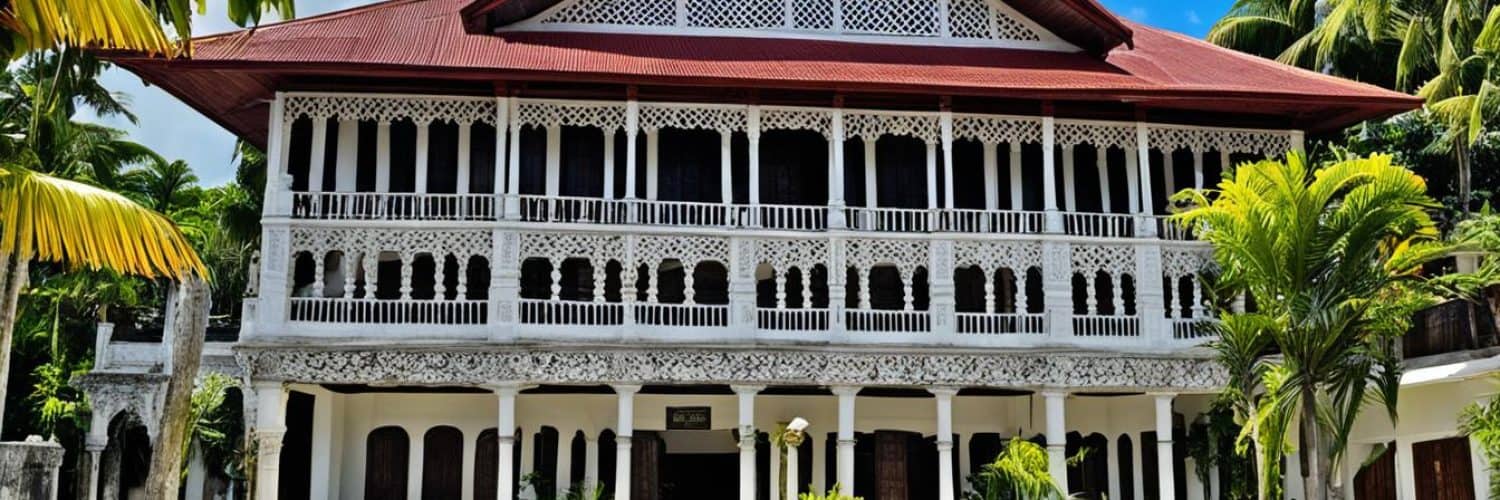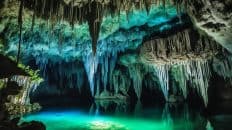Welcome to Bohol, Philippines, home to the historic Clarin Ancestral House. Step back in time as you visit this remarkable heritage site and delve into the rich history of this ancestral home. Built in 1840, the Clarin Ancestral House is a living testament to the Filipino-Spanish architecture of the past. With its fascinating architectural details, well-preserved collections, and significant cultural heritage, this house offers a captivating glimpse into the lives of the people who once called it home.
As you enter the Clarin Ancestral House, you’ll be greeted by its traditional features, including long slanting roofs covered with nipa leaves and a coral stone foundation. Inside, you’ll discover rough-hewn wooden posts, walls, and floors, an authentic representation of the Filipino-Spanish design. The high vaulted ceiling in the receiving hall adds to the grandeur of this historical house.
Declared a heritage site by the National Historical Institute, the Clarin Ancestral House now serves as a museum. Explore the family collections that date back to the American period, including antique furniture, American era artifacts, and a captivating display of Maria Clara gowns and barongs. You’ll also find a large dictionary of the English language in the museum’s small library, showcasing the family’s thirst for knowledge and cultural exchange.
The upper floor of the Clarin Ancestral House is where you’ll find the living quarters. Enjoy the natural light and fresh air that flood the rooms through the large windows adorned with capiz shell shutters. This thoughtful design allows for a comfortable and breezy atmosphere, even during hot days.
Indulge your taste buds at Cafe Olegario located on the ground floor of the Clarin Ancestral House. Delight in native Boholano delicacies and experience fine dining in the serene atmosphere of this historic setting. Whether you’re booking a private group dining experience or simply walking in for a quick bite, Cafe Olegario offers a memorable culinary experience.
The Clarin Ancestral House is strategically located in the town of Loay, just a short distance from Tagbilaran City, the capital of Bohol. Alongside other heritage homes, it sits on a lane leading to the Loay Church atop a hill. This central location allows visitors to conveniently explore the cultural sites and preserved history of the area.
Owned and maintained by the descendants of Don Aniceto Velez Clarin, a former governor of Bohol, the Clarin Ancestral House is a testament to the family’s political legacy in the province. Many of Don Aniceto’s descendants have followed in his footsteps, becoming mayors and congressmen in Bohol, thereby continuing the family’s commitment to public service.
Bohol is home to numerous other ancestral homes and heritage churches, collectively showcasing the province’s rich cultural heritage. These sites offer visitors a chance to immerse themselves in the beauty and history of Bohol, preserving the stories of the past for future generations to appreciate.
When visiting ancestral homes in Bohol, you have the unique opportunity to experience the Spanish-inspired architecture of the 20th century. These vintage houses, complemented by memorabilia and furniture collections, provide a deep dive into the lives of the families who once lived there. Immerse yourself in the culture and history of Bohol by exploring these architectural gems.
Preserving Bohol’s heritage is vital in maintaining its cultural identity. By safeguarding these ancestral homes, we ensure the continued appreciation of their historical significance and architectural integrity. Let us protect and cherish these treasures, allowing future generations to connect with the rich history of Bohol and the Clarin Ancestral House.
Key Takeaways:
- The Clarin Ancestral House in Bohol is a historical gem showcasing Filipino-Spanish architecture.
- The house is a well-preserved museum housing family collections dating back to the American period.
- Enjoy the architectural features of the upper floor, including large windows and capiz shell shutters.
- Indulge in native Boholano delicacies at Cafe Olegario, located on the ground floor of the house.
- Bohol is home to numerous ancestral homes and heritage churches, representing the rich cultural heritage of the province.
The Architecture of the Clarin Ancestral House
The Clarin Ancestral House in Bohol showcases a beautiful blend of Filipino-Spanish design elements. One of its prominent features is the long slanting roofs covered with traditional nipa leaves, which exude a charming and rustic appeal. The use of a coral stone foundation provides a solid base for the house, while the rough-hewn wooden posts add a touch of natural elegance. The wooden walls and floors, made of wide hardwood planks, further enhance the warm and inviting ambiance of the house.
The receiving hall of the Clarin Ancestral House is particularly noteworthy, as it boasts a high vaulted ceiling that creates a sense of grandeur and spaciousness. Despite the termite damage on the ceiling beams, efforts have been made to preserve the architectural integrity of the house. The intricate craftsmanship and attention to detail displayed throughout the house are a testament to the rich heritage and cultural significance it holds.
“The Clarin Ancestral House exemplifies the timeless beauty of Filipino-Spanish architecture. Its combination of traditional design elements and locally sourced materials is a testament to the ingenuity and artistry of the craftsmen of that era.”
Despite its age, the Clarin Ancestral House stands as a stunning example of architectural excellence, captivating visitors with its unique blend of Filipino and Spanish influences. Its sturdy construction and meticulous detailing have allowed it to withstand the test of time, providing a glimpse into the rich history and cultural heritage of Bohol.
The Collections in the Clarin Ancestral House Museum
The Clarin Ancestral House in Bohol now serves as a museum that houses a variety of family collections. Visitors to the museum can admire antique furniture such as intricately carved beds, dressers, and rocking chairs. The museum also showcases a collection of American era artifacts, including a huge earthen pot filled with centavo coins, antique jars and lamps, and various kitchen wares. One notable display in the museum is a collection of Maria Clara gowns and barongs.
Additionally, visitors can find a large dictionary of the English language in the museum’s small library.
A Glimpse into the Past
“The Clarin Ancestral House Museum offers a fascinating glimpse into the past through its diverse collection of family heirlooms and historical artifacts. From antique furniture to American era relics, the museum provides a rich cultural experience for visitors of all ages.”
Exploring the Treasures
Step inside the museum and be transported to a bygone era. The antique furniture on display showcases the intricate craftsmanship of the past, with each piece telling its own story. Visitors can marvel at the elegant beds, ornate dressers, and beautifully crafted rocking chairs, immersing themselves in the grandeur of the time.
The American era artifacts offer a glimpse into the influence of American culture on Bohol during that period. The earthen pot filled with centavo coins is a testament to the economic practices of the time, while the antique jars and lamps give a peek into the daily lives of the people.
One of the highlights of the museum is the collection of Maria Clara gowns and barongs. These traditional Filipino garments are meticulously preserved, allowing visitors to admire the beauty and craftsmanship of the past. The collection showcases the rich cultural heritage of Bohol and the Philippines as a whole.
As visitors explore the museum’s small library, they will come across a large dictionary of the English language. This serves as a reminder of the importance of language and education in shaping our history and culture.
A Visual Delight
| Antique Furniture | American Era Artifacts | Maria Clara Gowns and Barongs |
|---|---|---|
Visitors to the Clarin Ancestral House Museum are in for a visual treat. The antique furniture exudes elegance and charm, taking visitors back in time to an era of exquisite craftsmanship. The American era artifacts offer a glimpse into the influence of American culture on the Philippines, while the Maria Clara gowns and barongs showcase the rich cultural heritage of the country.
The museum’s vast collection of family heirlooms and historical artifacts provides a unique opportunity to appreciate and learn about Bohol’s heritage. Whether you’re a history enthusiast, an art lover, or simply curious about the past, a visit to the Clarin Ancestral House Museum is sure to leave a lasting impression.
The Upper Floor of the Clarin Ancestral House
The Clarin Ancestral House in Bohol is a two-story house, with the living quarters located on the upper floor. The upper floor features large and wide windows that provide ample natural light and fresh air circulation. The windows are adorned with capiz shell shutters that can be slid to the side, allowing the windows to be fully opened. This design feature ensures that the house remains cool even during hot days.
The living quarters on the upper floor of the Clarin Ancestral House are designed to maximize comfort and enhance the overall living experience. The large windows allow for plenty of natural light to brighten the space, creating a warm and inviting atmosphere. These windows not only serve as sources of illumination but also offer picturesque views of the surrounding landscape, allowing residents to connect with nature.
The capiz shell shutters that adorn the windows are not only decorative but also functional. They provide privacy and allow for the regulation of airflow and ventilation within the living quarters. By sliding the shutters to the side, residents can fully open the windows, promoting fresh air circulation and creating a pleasant indoor environment. This design element ensures that the living quarters are airy and well-ventilated, providing a refreshing and comfortable ambiance.
Moreover, the capiz shell shutters add an elegant touch to the overall aesthetic of the upper floor. Their delicate and translucent nature allows diffused light to enter the space, creating a soft and ethereal atmosphere. This unique feature adds a touch of timeless beauty to the living quarters, further enhancing the charm of the Clarin Ancestral House.
Overall, the upper floor of the Clarin Ancestral House embodies a harmonious blend of functionality and aesthetics. The combination of large windows, capiz shell shutters, and careful attention to fresh air circulation creates an inviting and comfortable living space. It is a testament to the thoughtful design and architectural brilliance of this historical treasure.
Cafe Olegario in the Clarin Ancestral House
The ground floor of the Clarin Ancestral House is occupied by Cafe Olegario, a cozy café that offers native Boholano delicacies. Visitors can indulge in a culinary journey and savor dishes that highlight the flavors and traditions of Bohol.
At Cafe Olegario, guests can immerse themselves in the rich culinary heritage of the region. The café is known for its mouthwatering native delicacies, including the famous torta Loayan – a flavorful omelet made with local ingredients. For those with a sweet tooth, puto, a traditional rice cake, served with a steaming cup of hot chocolate is a must-try. Another delightful delicacy on the menu is putomaya, a sumptuous dish made with rice boiled in coconut milk, flavored with ginger juice, and sweetened with sugar. Every bite tells a story of Bohol’s vibrant food culture.
Cafe Olegario offers a unique dining experience in a serene garden setting, providing a perfect blend of exquisite cuisine and a relaxed ambiance. Whether you’re looking for a place to book a fine dining experience for a special occasion or simply want to enjoy a casual meal, Cafe Olegario welcomes both group bookings and walk-in guests.
The Delights of Cafe Olegario:
- Torta Loayan – A flavorful omelet highlighting local ingredients
- Puto with Hot Chocolate – A traditional rice cake paired with a rich and indulgent hot chocolate
- Putomaya – Rice boiled in coconut milk, infused with ginger juice, and sweetened with sugar
Exquisite Dining in a Tranquil Garden Setting
Escape the bustle of everyday life and indulge in the native Boholano delicacies at Cafe Olegario. Whether you’re a food enthusiast, a culture lover, or simply someone seeking a memorable dining experience, this charming café in the Clarin Ancestral House provides an inviting atmosphere to enjoy the rich flavors and heritage of Bohol.
Location of the Clarin Ancestral House
The Clarin Ancestral House is located in the charming town of Loay, just 18 kilometers away from the bustling capital city of Bohol, Tagbilaran City. The house holds a prominent position along the lane leading to the stairway that ascends to the picturesque Loay Church, perched atop a hill.
Loay is known for its rich collection of heritage homes, and the Clarin Ancestral House stands as a testament to the area’s cultural legacy. Many of Bohol’s other vintage houses, including several heritage homes, are nestled along roads adorned with beautiful gardens. This strategic placement not only adds to the allure of the properties but also allows visitors to conveniently explore the wealth of cultural heritage that permeates the region.
| Location | Distance from Tagbilaran City |
|---|---|
| Clarin Ancestral House | 18 kilometers |
| Loay Church | Located atop a hill along the lane adjacent to the Clarin Ancestral House |
Bohol’s heritage homes are not only architectural marvels but also provide a glimpse into the past, allowing visitors to appreciate the rich history and cultural significance of the area. Exploring the Clarin Ancestral House and other nearby heritage homes in Loay offers a fascinating journey through time, immersing visitors in the beauty and preserved history of Bohol.
The Owners of the Clarin Ancestral House
The Clarin Ancestral House, located in Bohol, is steeped in political history and is the residence of the prominent Clarin family. The house is named after and belonged to Don Aniceto Velez Clarin, a former governor of Bohol. Don Aniceto played a vital role in shaping the province’s political landscape during his time in office.
One of Don Aniceto’s sons, Jose Aniceto Butalid Clarin, made history by becoming the first senator of the 11th district—comprising the provinces of Bohol, Misamis, and Surigao—under the U.S. Congress’ Jones Law. This achievement further elevated the family’s political influence and legacy in Bohol.
Throughout generations, the Clarin family has maintained a strong presence in local politics, with many of Don Aniceto’s descendants actively involved in public service, holding positions as mayors and congressmen in Bohol. This political dynasty demonstrates the family’s dedication to public service and their commitment to continuing their ancestors’ legacy.
Today, the Clarin Ancestral House and its invaluable historical significance are preserved and maintained by the descendants of Don Aniceto Velez Clarin and exemplify the family’s lasting impact on Bohol’s political landscape.
| Name | Position |
|---|---|
| Don Aniceto Velez Clarin | Former Governor of Bohol |
| Jose Aniceto Butalid Clarin | First Senator of the 11th District |
| Descendants | Mayors and Congressmen in Bohol |
Other Ancestral Homes in Bohol
Aside from the Clarin Ancestral House, Bohol is fortunate to be the home of several other remarkable ancestral homes and heritage churches. These architectural treasures serve as testaments to the province’s rich cultural heritage and are worth exploring during your visit to Bohol.
Heritage Churches
Bohol boasts a collection of beautiful heritage churches that inspire awe with their grandeur and historical significance. These churches have stood the test of time and offer visitors a chance to witness the architectural prowess of the past. Some notable heritage churches in Bohol include:
| Church | Location |
|---|---|
| Baclayon Church | Baclayon, Bohol |
| Loon Church | Loon, Bohol |
| Dauis Church | Dauis, Bohol |
Ancestral Homes
Bohol’s ancestral homes offer a glimpse into the lives of the families who once inhabited them. Some of these homes have been lovingly preserved by their descendants, while others have been recognized as national treasures. Immerse yourself in the beauty and history of Bohol by visiting these ancestral homes:
- Murillo Velarde Ancestral House, Loay
- Rocamora Ancestral House, Loon
- Velez Ancestral House, Tagbilaran City
“These ancestral homes and heritage churches tell stories of our ancestors and their contributions to our culture and history. Exploring these sites allows us to appreciate the richness of our heritage and understand the journey that has brought us to where we are today.” – Local Historian
Take the opportunity to visit these cultural sites and national treasures in Bohol to experience the vibrant history and heritage of the province.
Cultural Immersion through Ancestral Homes in Bohol
Experience the enchanting allure of Spanish-inspired architecture and vintage houses as you explore the ancestral homes in Bohol. These architectural marvels, constructed with coral stone and hardwood, transport you back in time, revealing the grandeur and elegance of the past.
Step inside these ancestral homes, and you’ll discover a treasure trove of memorabilia, antique furniture, and captivating collections. Each item offers a glimpse into the lives of the families who once called these houses their homes. From intricately carved beds to ornate dressers and rocking chairs, these antique furniture pieces tell stories of a bygone era.
One highlight of these ancestral homes is their exquisite collections. You’ll find yourself immersed in the rich heritage of Bohol as you marvel at the display of Maria Clara gowns and barongs, showcasing the traditional attire of yesteryear. Whether it’s a vintage photograph, a handwritten letter, or a priceless artifact, each item adds another layer to the tapestry of history.
Exploring these ancestral homes is a captivating way to soak in the culture and history of Bohol. As you walk through the meticulously preserved rooms, each step transports you deeper into the past. The ambiance, the aroma, and the stories whispered through the halls create an immersive experience you won’t soon forget.
Immerse yourself in the rich cultural heritage of Bohol as you journey through these ancestral homes, marveling at the Spanish-inspired architecture, vintage houses, and the fascinating memorabilia and furniture collections they hold. It’s an exploration that promises to leave you with a deeper appreciation for the captivating history that shaped this enchanting province.
Preserve Bohol’s Heritage
The preservation of Bohol’s ancestral homes is of utmost importance in order to safeguard and uphold its exceptional cultural heritage. These homes not only serve as invaluable repositories of cultural artifacts but also offer a captivating glimpse into the rich history of the region. By actively preserving these architectural marvels, we can ensure that future generations have the opportunity to appreciate and learn from the significant historical legacy housed within these unique heritage sites. It is our collective responsibility to protect and care for these ancestral homes, preserving their architectural integrity and safeguarding the fascinating narratives they hold, showcasing the story of Philippine history.
Why Preservation Matters
Preserving Bohol’s ancestral homes is vital for several key reasons:
- Cultural Artifacts: These ancestral homes house a vast array of cultural artifacts that serve as tangible links to the past. From antique furniture to vintage photographs, these treasures provide invaluable insights into the lives and traditions of previous generations.
- Architectural Integrity: The preservation of these architectural gems ensures that their original beauty and character are upheld for future generations to appreciate. From the intricate carvings to the unique design elements, every detail contributes to the overall architectural integrity and historical significance of these heritage sites.
- Historical Significance: Ancestral homes in Bohol are not merely structures; they hold immense historical significance. They are a testament to the people, events, and cultural influences that have shaped the region over the years. Preserving these homes allows us to maintain a tangible connection to the past and honor the stories of those who came before us.
The Role of Preservation Efforts
Preserving Bohol’s heritage requires a collective effort involving local communities, government agencies, and tourism organizations. Key preservation efforts include:
- Restoration and Maintenance: Regular maintenance and restoration work are essential to ensure the stability and longevity of ancestral homes. This includes structural repairs, pest control measures, and conservation of original materials.
- Educational Initiatives: Promoting awareness and understanding of the importance of heritage preservation through education initiatives helps cultivate a sense of pride and responsibility among residents and visitors alike.
- Tourism Development: Developing sustainable tourism programs that highlight the cultural significance of ancestral homes can generate revenue for their preservation while also promoting appreciation and respect for the local heritage.
In preserving Bohol’s ancestral homes, we not only safeguard the tangible structures but also ensure the continuing legacy and cultural identity of the region. It is through these efforts that we foster a deep appreciation for our history and leave a lasting legacy for future generations to cherish and learn from.
| Benefits of Preservation | Preservation Efforts |
|---|---|
| ☑ Safeguards cultural artifacts | ☑ Restoration and maintenance |
| ☑ Upholds architectural integrity | ☑ Educational initiatives |
| ☑ Preserves historical significance | ☑ Tourism development |
Conclusion
The Clarin Ancestral House in Bohol is a captivating heritage site that truly reflects the preserved history and cultural richness of the province. With its well-preserved architecture, impressive collections of antiques, and significant historical background, this house is a must-visit for all tourists exploring Bohol. It offers a unique opportunity to step back in time and gain a deeper understanding of the heritage and traditions of this beautiful region.
Exploring the Clarin Ancestral House provides visitors with an enriching experience that goes beyond sightseeing. It allows them to immerse themselves in the captivating stories and fascinating artifacts that bring the past to life. Whether you’re fascinated by the architectural beauty, the antique furniture, or the historical significance, this heritage site has something to offer everyone.
When planning your visit to Bohol, don’t miss the opportunity to explore the Clarin Ancestral House. It is a true gem that highlights the importance of preserving our history and cultural heritage. By supporting tourism initiatives that promote the preservation of such sites, we not only contribute to the local economy but also ensure that future generations can continue to appreciate and learn from the rich history of Bohol and the Philippines as a whole.
FAQ
Is the Clarin Ancestral House in Bohol a historical site?
Yes, the Clarin Ancestral House is a historical site that dates back to 1840.
What is the architectural style of the Clarin Ancestral House?
The Clarin Ancestral House showcases a Filipino-Spanish design with long slanting roofs, coral stone foundation, and wooden walls and floors.
What can visitors see in the Clarin Ancestral House Museum?
Visitors to the museum can admire family collections, American era artifacts, antique furniture, Maria Clara gowns, barongs, and a large dictionary in the small library.
What is the layout of the Clarin Ancestral House?
The house is a two-story structure with the living quarters located on the upper floor. It features large windows with capiz shell shutters for ample natural light and fresh air circulation.
What is Cafe Olegario in the Clarin Ancestral House?
Cafe Olegario is a cozy cafe located on the ground floor of the Clarin Ancestral House, offering native Boholano delicacies and fine dining options.
Where is the Clarin Ancestral House located?
The Clarin Ancestral House is situated in the town of Loay, approximately 18 kilometers from Tagbilaran City, the capital of Bohol.
Who are the owners of the Clarin Ancestral House?
The Clarin Ancestral House is owned and maintained by the descendants of Don Aniceto Velez Clarin, a former governor of Bohol.
Are there other ancestral homes in Bohol?
Yes, Bohol is home to numerous ancestral homes and heritage churches that showcase the rich cultural heritage of the province.
Why is it important to preserve Bohol’s heritage?
Preserving Bohol’s heritage is crucial for maintaining its rich cultural history and ensuring that future generations can appreciate and learn from these historical sites.


















Add comment